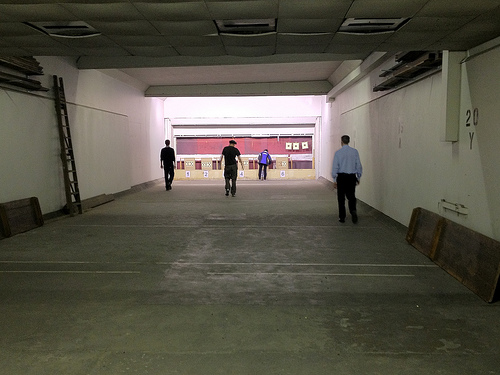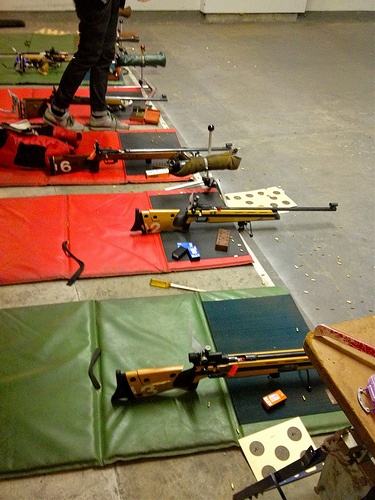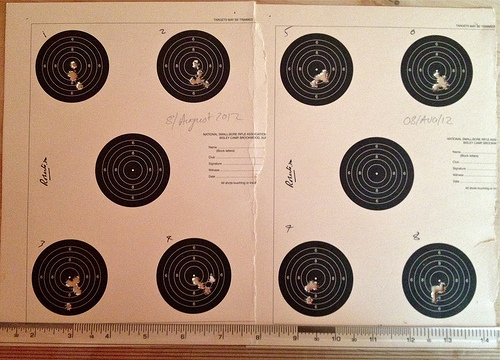I settle, relaxing all my muscles: feet to legs to bum to back to arms. I’m essentially slumped. A bit of pain in my left hand: that’s not quite right. Perhaps I just have to get used to it.
I look at the concentric circles; shuffle to the left, wriggle my hips. Relax again.
Close my eyes. Breathe in, out; in, out; and open my eyes again. Take stock. Shuffle infinitesimally to the left. Eyes closed; breathe once, twice, and open them.
Apparently, the French think our success in the Olympic track cycling events is something to do with the wheels on our bikes being somehow more ’round’ than theirs. A more precise determination of π perhaps? And again, the New Zealanders are wondering what is special about our equipment compared with theirs (stop sniggering at the back).
It is somewhat disheartening to think that two hundred years after the Enlightenment people are still thinking in terms of magic or trickery to explain what, to be fair, is a staggering record in a sport (Team GB won, for the record, seven out of a possible ten gold medals; a silver in one event and a bronze in a ninth. We were disqualified from one event).
The truth is of course, it’s down to bloody hard graft. And a tiny touch of science.
We normally think of science in terms of observation; hypothesis; experiment. But there are different types of science, aren’t there? There is basic science, there is translational science, and there is applied science. None of those is exactly technology (or medicine, come to that). And what we are seeing, described by British Cycling’s performance director Dave Brailsford, is some sort of applied science—with, perhaps, just the tiniest bit of basic science, of experiment, thrown in.
For example, the cyclists take their own pillows with them when they go away. They learn to wash their hands more effectively, so they come down with fractionally fewer colds and sniffles, which means they have fractionally better performance. And a percentage point here; half a percent there: it all adds up to those fractions of a second that make the difference between an Olympic medal and historical oblivion.
I’ve been doing a little bit of this myself recently, in an Olympic sport no less. I’m not likely to be winning any medals any time soon, but (like my missed chance at a backgammon quarter-blue when I was at Oxford), I do have a realistic chance of competing at high levels.
I am in my own little world. A gash piece of plastic—cut from a milk carton—is covering my left eye. My right eye is up against the sight; my hearing muffled by the ear defenders; the stock firmly against my shoulder.
I breathe in and out and in and out and just as the bull centres the second time I bend my forefinger and the rifle leaps up—a bang, the familiar, addictive smell of cordite—I count to three and mark where the rifle is now pointing. Finally I lift two fingers from the grip and pull back the bolt, sending the brass casing flying somewhere to my right, and reach for another round.
For the last three or four months, on most Wednesday evenings, I’ve been letting myself in through a metal doorway under Blackfriars Bridge and going to the Stock Exchange Rifle Club. There, I’ve been learning how to make little tiny holes in small pieces of paper with tiny pieces of lead.
Now, target shooting is quite unlike shooting for food. I’ve done that, when when Mike shoved a Lee Enfield in my hand and told me to kill a pig that had just gone for cover in a bush. One shot, one pig curry. But what we do at the SERC is a little more refined. I started off with no equipment other than the rifle, a glove and a wooden support (‘block’) to rest my hand on. I was pretty rubbish at first (as you’ll know if you’ve been keeping track of my progress on Facebook). But after learning how to shoot five rounds that consistently hit a small area (a ‘grouping’), last week I got fitted up with a shooting jacket that incorporates a sling. The sling holds the rifle so that when you lie down you can take your right (or firing) arm and hand away, and the rifle should still be pointing at the centre of the target.
The idea, ultimately, is to be able to put a 0.22 round through a hole a centimeter across from 50 meters away. Ten times. Then, if you want to be an Olympic gold medallist, you have to repeat the feat a further five times.
So this week, I got into my jacket, settled down, and fired ten rounds: five at each of two targets. Took a rest, repeated the exercise. And then shot two more details: eight targets in all, forty rounds of 0.22 ammunition.
And look:
As the night progressed, so my groupings got smaller. Follow the numbers, 1 through 8. This is all down to practice, yes, but also to those ‘marginals’ that Dave Brailsford talks about. Each time I shot, I was improving my position, my breathing, my settling on a natural point of aim. Each time each parameter is tightened, I do a little bit better.
Each week, I pick up another little tip. Each detail, I try to implement it. There is a science behind it: not just an applied science of what is known, but also a little experiment as I see how it applies to me. Exactly as the Team GB cyclists gather data and apply it to themselves, and see what a difference it makes.
At this stage, the grouping is the thing. Hitting the centre of the bull—each time, every time—is something I’ll start working on next week. And then I’ll be able to put some numbers on my performance.
Isn’t that science?






Very nice. I had no idea, not being a Facebooker.
So… are you going to back that improvement up with some statistics, like measurements away from the centre, complete with a standard error, or perhaps the application of a kernel density clustering function?
I know, I know… I’ll get my coat.
heh heh. I could do, you know, if I was really really sad…
As I hinted though, I’m going to start using those targets ‘properly’ and will start putting a single round into each ball. As there are rings within the black it’s trivial to quantify the distance from the centre each time, and indeed you get a score. So 10 for each bull. A perfect score on those cards is 100. Inbuilt stats, how do you like that?
The reason Team GB is doing so well relates to a five-letter word beginning with ‘M’.
“Mardy”? “Mouse”? “Movie”?
Actually, notice how we do well at sports where we’re sitting down or hitting people? I think that says something about us.
Moxie.
With cycling, its down to the scientific shape of the seat – all can you can do if you sit on one is to peddle like hell to get away from it. – The opposite to the carrot and donkey principle.
Sitting down is my favourite sport. I go with the adage, ‘No pain no pain.’
It is Intriguing Richard how you shoot predominantly low right?
Actually John, last Wednesday I started shooting ten ball targets, but on the sighting detail my five round grouping was completely within the bull. I’m still tending to be a bit low, but definitely fixing my pull to the right problem.
We’ll all expect to see you on the podium in 2016 then.
With a bit of luck… and maybe some Lottery funding?!